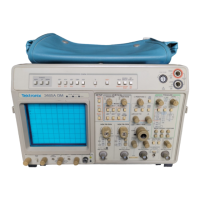Operation
Delta-Delay-Time
Use the delayed (8) sweep to magnify both ends of a time interval for the best
measurement accuracy available. Appendix D gives relative accuracies of the various
time-measurement techniques.
Measure Time or Frequency with Delta-Delay-Time
1 . Display the time interval or signal period with the A Sweep running
as
fast
as
possible, unmagnified, up to one speed slower than the fastest
SEC/DIV setting. If the interval is a propagation delay or other two-
signal measurement, display the signals
on
CH
1
and
CH
2 and trigger
A Sweep
on
the earlier of the two.
2.
Pull
SEC/DIV out to activate 8 Sweep
and
light the A SWP and 8 SWP
indicators
(INTEN
mode). (If you inadvertently chose the fastest
A-
Sweep speed, the
CH2
Delay Match function will
be
active. See the
"Operator Checks
and
Adjustments' section.)
3.
If a 8-Trigger Mode indicator is on, select
RUN
AFT
DL
Y.
(If
an
A-
Trigger Mode indicator is
on,
the 8-Trigger has
been
set previously to
RUN
AFT
DL
Y.)
4.
Select
l1t
or 1/l1t while the SEC/DIV knob
is
out.
5.
Adjust
l1
REF
OR
DL Y
POS
and
l1
to place the pair of intensified zones
at the beginning
and
end
of
the interval of interest. If the A Sweep
terminates just after the intensified zones, you can move the HOLDOFF
control
and
set it at MIN.
6.
Turn SEC/DIV clockwise with the knob pulled out to magnify the ends
of the interval
on
the 8 Sweep while observing the entire interval
on
the
A
Sweep (AL T mode). Use TRACE
SEP
to separate the A-Sweep
and
8-Sweep traces
as
desired.
7.
Set
l1
REF
and
l1
to superimpose the magnified displays of the
beginning
and
end
of
the interval. The readout shows the interval.
Without the crr, make delta-delay-time measurements only
in
the
RUN
AFT
DL
Y trigger mode, where the 8 Sweep runs immediately after the
set delays. If the 8 Sweep
is
triggered, it waits for a trigger after the set
delay,
so
the actual delay time may differ from the delay or l1t readout
by
as
much
as
twice the signal period.
2465A/2455A/2445A Operators
2-15

